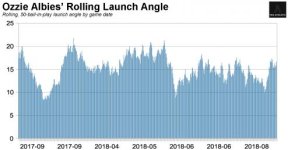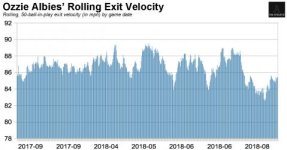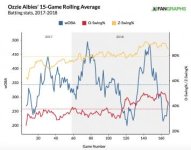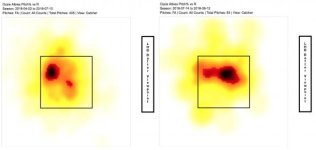Goober Pyle
New member
https://theathletic.com/471605/2018/08/14/sarris-whats-going-on-with-ozzie-albies/
By Eno Sarris
April! Do you remember it? We might vaguely recall some bad weather, some rain, and of course Ozzie Albies, making it rain. At five-foot-nine, and 160 pounds of pure steel, Albies slugged an incomprehensible .647 in April, causing us all to appreciate the greatness we were witnessing, and wonder how we’d missed all this power in front of us.
Seems a long time ago now. The Braves have gotten the worst production in the National League from their second basemen in the last 30 days, and Albies has been 50 percent worse than league average.
In one way, Albies’ story is the story of the Braves. One man doesn’t make an offense, but the same way that the second baseman has surprised, the Braves offense has been hitting over their heads, perhaps. Over at FanGraphs, no team in baseball is projected to see their runs scored per game go down as much going forward, for example.
Team RS/G Projected RS/G Diff RS
Braves 4.81 4.32 -0.49
Red Sox 5.49 5.14 -0.35
Pirates 4.57 4.29 -0.28
Reds 4.55 4.31 -0.24
Cubs 4.92 4.72 -0.20
But if you look at the overperformers on the roster, there are compelling backstories for the change, just as there was for Albies earlier this season. Johan Camargo? He found his patience. Nick Markakis? He’s hitting the ball harder than ever. Ronald Acuña? He’s just this good, right away.
So let’s take a look at what’s going on with Albies. If the story holds, and the fix is evident, maybe there won’t actually be all this regression coming for the Braves offense. Maybe Albies will return to grace and keep the lineup moving.
Under the hood, Albies isn’t quite hitting the ball the same way as he was early this season. In particular, some of his lift is gone, as you can see from his rolling launch angle.

But his overall angle this year (15.6) is indistinguishable from his angle last year (15.0) and you can see that he’s begun lifting the ball well recently, when he’s been struggling.
He’s not hitting the ball as hard either.

We do have a hamstring injury that occurred in late July, and that’s probably why you’re seeing the dip all the way down to 82. Exit velocity changes can be an indicator of overall health, and that valley is right in line with the timing of the injury.
But his overall exit velocity was down before the injury, and not it’s not back up to where it was earlier this season, when he was hitting for more power. Given that his mechanics look largely similar, it’s worth pointing out that plate discipline can lead to harder-hit balls and more fly balls… and that Albies’ plate discipline has fallen on harder times as the season has progressed.

He’s reaching and swinging more often now than he was earlier in his career. That’s not good, but it’s changed before and could change again. What’s the pitch that’s tempting him out of the zone?
Our first clue to finding the source of Albies’ issue is that it’s not hurting him equally on both sides of the plate. Over the last thirty days, Albies has been 30 percent better than the league from the right side. From the left side? He’s hitting .116/.174/.163. Oof.
Pitchers have begun throwing their four-seamers in on Albies’ hands when he hits from the left side. Take a look at where they threw it early (left) vs in the last thirty days (right), and it pops out at you.

As a result, Albies’ whiff rate against fastballs from righties has risen from 11 percent to 16 percent. More dramatic has been the rise in his whiff rates against breaking pitches from righties (from 10 percent up to 18 percent), which comes from a rise in swing rates (from 49 percent on breakers to 59 percent over the last month). Pound him in with the fastball, and drop the breakers away, and you’ve got the righty book to Albies right now.
We saw some of this yesterday, as Marlins starter Pablo López threw a four-seamer inside and coaxed a swing from Albies.
On his next pitch to Albies, López went away with the curve.
That’s the way out for Albies.
Provided his hamstring isn’t hurting him more from the left side, where it’s his stride leg, it looks like this recent funk is really a struggle to adjust to the newest scouting report. He’s never been a passive hitter, but this is the lowest Albies’ walk rate has ever been in his carer. His swing and reach rates are all up from last year, and then in the recent past, they’re up even further on certain pitches.
In fairness, Albies had such a great April, he probably thought he could hit everything — and wasn’t that far off. But it’s not April anymore, and if the Braves are going to stave off regression in the lineup, they’ll need Albies to learn to lay off high-and-tight and low-and-slow.
Seems like something the exuberant one can figure out, especially since a few key takes give us the sense he’s working on it.
By Eno Sarris
April! Do you remember it? We might vaguely recall some bad weather, some rain, and of course Ozzie Albies, making it rain. At five-foot-nine, and 160 pounds of pure steel, Albies slugged an incomprehensible .647 in April, causing us all to appreciate the greatness we were witnessing, and wonder how we’d missed all this power in front of us.
Seems a long time ago now. The Braves have gotten the worst production in the National League from their second basemen in the last 30 days, and Albies has been 50 percent worse than league average.
In one way, Albies’ story is the story of the Braves. One man doesn’t make an offense, but the same way that the second baseman has surprised, the Braves offense has been hitting over their heads, perhaps. Over at FanGraphs, no team in baseball is projected to see their runs scored per game go down as much going forward, for example.
Team RS/G Projected RS/G Diff RS
Braves 4.81 4.32 -0.49
Red Sox 5.49 5.14 -0.35
Pirates 4.57 4.29 -0.28
Reds 4.55 4.31 -0.24
Cubs 4.92 4.72 -0.20
But if you look at the overperformers on the roster, there are compelling backstories for the change, just as there was for Albies earlier this season. Johan Camargo? He found his patience. Nick Markakis? He’s hitting the ball harder than ever. Ronald Acuña? He’s just this good, right away.
So let’s take a look at what’s going on with Albies. If the story holds, and the fix is evident, maybe there won’t actually be all this regression coming for the Braves offense. Maybe Albies will return to grace and keep the lineup moving.
Under the hood, Albies isn’t quite hitting the ball the same way as he was early this season. In particular, some of his lift is gone, as you can see from his rolling launch angle.

But his overall angle this year (15.6) is indistinguishable from his angle last year (15.0) and you can see that he’s begun lifting the ball well recently, when he’s been struggling.
He’s not hitting the ball as hard either.

We do have a hamstring injury that occurred in late July, and that’s probably why you’re seeing the dip all the way down to 82. Exit velocity changes can be an indicator of overall health, and that valley is right in line with the timing of the injury.
But his overall exit velocity was down before the injury, and not it’s not back up to where it was earlier this season, when he was hitting for more power. Given that his mechanics look largely similar, it’s worth pointing out that plate discipline can lead to harder-hit balls and more fly balls… and that Albies’ plate discipline has fallen on harder times as the season has progressed.

He’s reaching and swinging more often now than he was earlier in his career. That’s not good, but it’s changed before and could change again. What’s the pitch that’s tempting him out of the zone?
Our first clue to finding the source of Albies’ issue is that it’s not hurting him equally on both sides of the plate. Over the last thirty days, Albies has been 30 percent better than the league from the right side. From the left side? He’s hitting .116/.174/.163. Oof.
Pitchers have begun throwing their four-seamers in on Albies’ hands when he hits from the left side. Take a look at where they threw it early (left) vs in the last thirty days (right), and it pops out at you.

As a result, Albies’ whiff rate against fastballs from righties has risen from 11 percent to 16 percent. More dramatic has been the rise in his whiff rates against breaking pitches from righties (from 10 percent up to 18 percent), which comes from a rise in swing rates (from 49 percent on breakers to 59 percent over the last month). Pound him in with the fastball, and drop the breakers away, and you’ve got the righty book to Albies right now.
We saw some of this yesterday, as Marlins starter Pablo López threw a four-seamer inside and coaxed a swing from Albies.
On his next pitch to Albies, López went away with the curve.
That’s the way out for Albies.
Provided his hamstring isn’t hurting him more from the left side, where it’s his stride leg, it looks like this recent funk is really a struggle to adjust to the newest scouting report. He’s never been a passive hitter, but this is the lowest Albies’ walk rate has ever been in his carer. His swing and reach rates are all up from last year, and then in the recent past, they’re up even further on certain pitches.
In fairness, Albies had such a great April, he probably thought he could hit everything — and wasn’t that far off. But it’s not April anymore, and if the Braves are going to stave off regression in the lineup, they’ll need Albies to learn to lay off high-and-tight and low-and-slow.
Seems like something the exuberant one can figure out, especially since a few key takes give us the sense he’s working on it.
